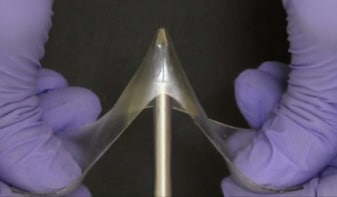
“Structurally colouring” carbon nanotubes with an amorphous layer of titanium dioxide not only makes them easier on the eye, it also makes them flame-resistant. This is the finding of researchers from Tsinghua University in Beijing, China, who say that these new properties should make it easier to employ nanotubes in wearable devices, smart textiles and functional coatings.
Carbon nanotubes (CNTs) are rolled-up sheets of carbon one atom thick. Thanks to their excellent electrical and mechanical properties, they show promise for many applications, including ultra-strong fibres and conductive wires. They do, however, have two inherent shortcomings: they are jet black in colour, which makes them aesthetically unattractive for some applications; and they are flammable, which means they cannot be employed in high-temperature environments where oxygen is present.
Colour control
Researchers led by Rufan Zhang of Tsinghua University’s Department of Chemical Engineering have now coated CNTs with amorphous TiO2 layers using a technique called atomic layer deposition (ALD). They report that this technique worked for both CNT fibres and CNT membranes and that they could control the colour by tuning the thickness of the coatings.
The team found that as well as increasing the structural and functional diversity of the CNTS, the coating process also makes them resistant to flames. Indeed, the materials can withstand eight hours of burning – unlike ordinary CNTs, which burn easily.
Chemically stable
Compared with conventional dyes and pigments, which are chemically unstable and cannot be used for colouring CNTs, the TiO2 coating-based structural colours can endure 2000 cycles of laundering, Zhang says, and more than 10 months of exposure to high-intensity ultraviolet irradiation.
The technique is convenient, simple, easily repeatable and easy to scale up, he adds. It produces brilliant, controllable colours, such as indigo, yellow-brown, blue, purple and green. Importantly, it does not affect the intrinsic electrical and mechanical properties of the CNTs.

Carbon nanotubes help space-bound electronics resist radiation damage
The TiO2-coated CNTs might be used in numerous cutting-edge applications, Zhang tells Physics World. “These include ultra-strong fibres, wearable devices, smart textiles and devices that operate in high-temperature environments (such as aircraft, missiles and rockets), optical displays, colorimetric sensors, anti-counterfeiting devices, information encryption, multicolour passive photonic displays, optical fibres and lasers, to name just a few.”
The researchers now aim to further expand the colour range of their CNTs. “We will also further investigate the excellent performance of the coloured CNTs and look into interdisciplinary applications,” Zhang says.
The work is described in Science Advances.



